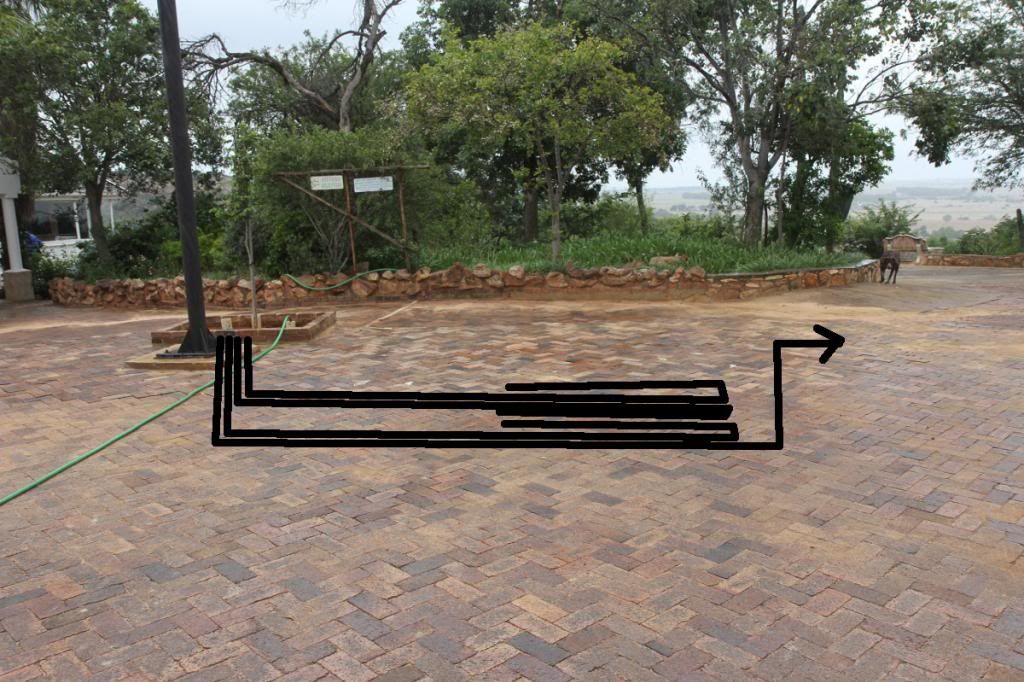I have a property on a hill that is VERY prone to lightning strikes. I now eventually erected a lightning pole to try and sort out the problem. 27m high and R16K later. Readings I get with an earthing meter spikes to 4ohm and then settles at about 0.1 ohm. The electrician used a meter with 4 wires, three connected to short earthing spikes that he hit into the ground about 1m away around the pole and the 4th connected to the base of the lightning pole.
I am showing a picture trying to explain what I did. I used +- 10mm bare copper cable. It goes down into a big hole that I dug into the very rocky earth. The hole is 1.5m deep, 6 m long and 1.5m wide. The cable then runs the length of the hole, 6m, and turns back for another 3m. There is 3 of these cables. Then I took a 4th one, laid it into the hole the same way, but instead of turning back for 3m, it goes up and out of the hole at the far end. The hole was then filled up with soil and compacted with paving over the top. The picture shows the cables neatly spaced, not touching but in fact they are all over the show crossing and touching each other. Only in hind sight I realized that it probably would have been better to space them apart and not touching. Maybe it does not matter and maybe it is better the way I did it?
My idea was to use this 4th cable and lengthen it to some electronic equipment, cameras and IT stuff, 30 meters away, as an earthing point for the lightning protectors connected to the equipment. My problem is that I can not get a decent spike into the ground deep enough to give a decent earthing point to the lightning protectors.
But now I am getting cold feet and I worry that I am actually taking lightning strikes directly to my equipment. I have not done the extension of 30 meters yet, as I am scared and do not want to waste money. If it will work, what do I use for the 30m extension, bare copper cable as well, or will something cheaper suffice?
I am also thinking of running an earthing wire from the base of the lightning pole underneath the paving, to the point some 30m away. My logic tells me the lightning strike will follow the route to ground in the hole and not follow the earthing wire, but does it make any difference? At the end of the day it is just a different route and I do not think lightning is going to make an exception and just follow all possible routes?

I am showing a picture trying to explain what I did. I used +- 10mm bare copper cable. It goes down into a big hole that I dug into the very rocky earth. The hole is 1.5m deep, 6 m long and 1.5m wide. The cable then runs the length of the hole, 6m, and turns back for another 3m. There is 3 of these cables. Then I took a 4th one, laid it into the hole the same way, but instead of turning back for 3m, it goes up and out of the hole at the far end. The hole was then filled up with soil and compacted with paving over the top. The picture shows the cables neatly spaced, not touching but in fact they are all over the show crossing and touching each other. Only in hind sight I realized that it probably would have been better to space them apart and not touching. Maybe it does not matter and maybe it is better the way I did it?
My idea was to use this 4th cable and lengthen it to some electronic equipment, cameras and IT stuff, 30 meters away, as an earthing point for the lightning protectors connected to the equipment. My problem is that I can not get a decent spike into the ground deep enough to give a decent earthing point to the lightning protectors.
But now I am getting cold feet and I worry that I am actually taking lightning strikes directly to my equipment. I have not done the extension of 30 meters yet, as I am scared and do not want to waste money. If it will work, what do I use for the 30m extension, bare copper cable as well, or will something cheaper suffice?
I am also thinking of running an earthing wire from the base of the lightning pole underneath the paving, to the point some 30m away. My logic tells me the lightning strike will follow the route to ground in the hole and not follow the earthing wire, but does it make any difference? At the end of the day it is just a different route and I do not think lightning is going to make an exception and just follow all possible routes?





Comment